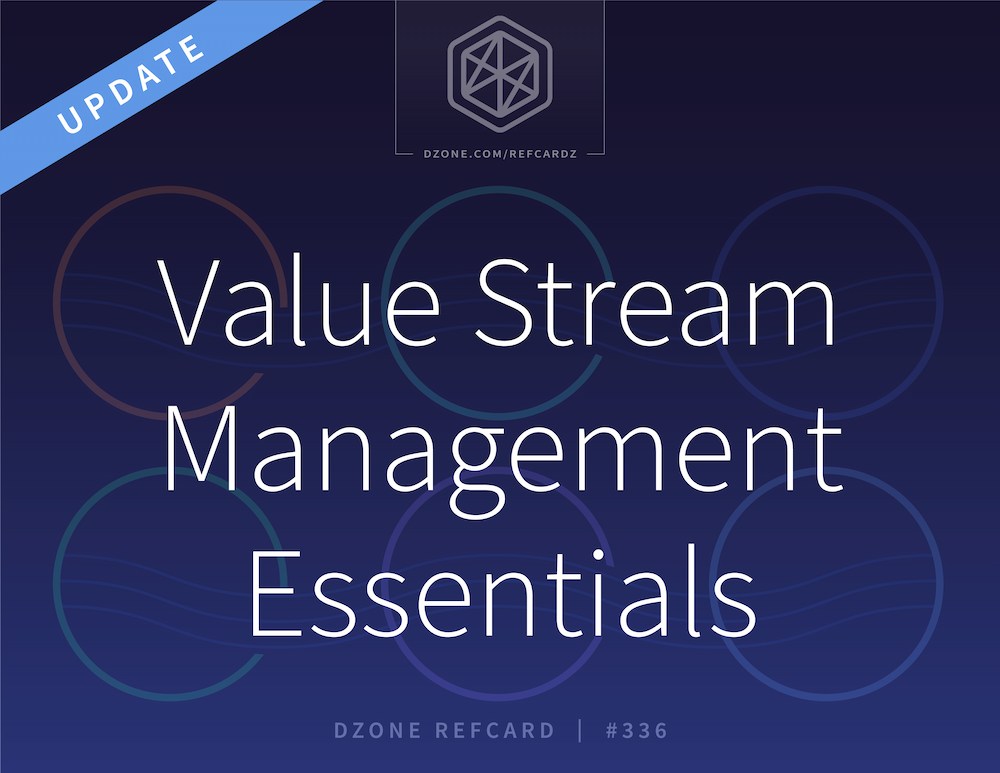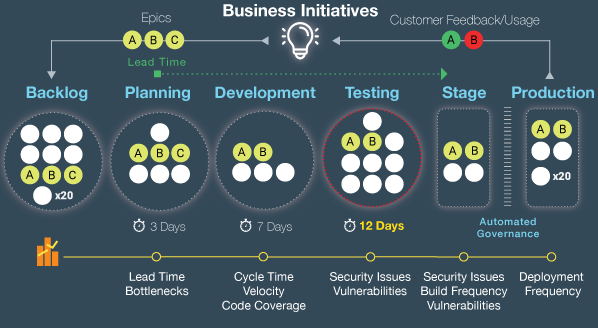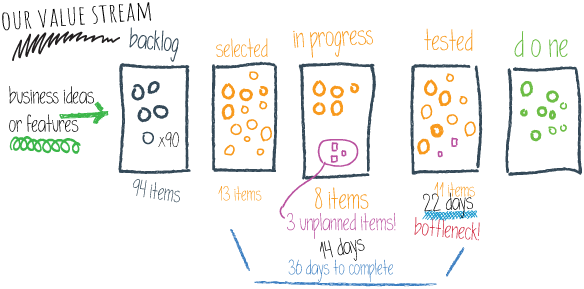VSM helps improve the three DevOps pillars of people, processes, and technology.
The People Challenge
Now more than ever, teams are working remotely and having a harder time collaborating in a fast-paced development environment. The lack of face-to-face interactions makes "water cooler" conversations a thing of the past. Standup meetings and retrospectives often suffer because it's not obvious how the team is functioning as a whole. It is difficult to know which team member is responsible for certain tasks, and even harder to know when those tasks have fallen behind.
VSM for the People
By tracking work in progress, VSM helps make the work visible, which creates a shared responsibility for the software produced and increased transparency, communication, and collaboration across development, IT/operations, and business teams. VSM, in many ways, starts to humanize DevOps by creating meaningful dialogue around current processes and encouraging a DevOps culture that embraces thinking outside of the box to solve traditional problems.
By adding visibility, teams obtain knowledge about everything that is required for an organization to deliver high-quality software and, therefore, tend to have more empathy for their coworkers. Visibility into how value is produced allows everyone from top-level executives to developers to look at the same data and have much more direct and transparent conversations.
When these groups are aligned, conversations become easier because expectations are set with data-driven analysis rather than feelings. When teams do not fully understand each other's responsibilities, this can cause a number of issues that ultimately delay throughput and can result in finger-pointing. Value stream management can revolutionize a company's culture by refocusing efforts through compassion and comradery.
The Process Challenge
When discussing processes, we tend to focus on how efficient we can make a particular workflow. This requires organizations to constantly reevaluate how they operate to identify new bottlenecks and develop a leaner alternative. Part of the luxury that comes with having a highly responsive, agile development organization is constantly juggling the requests of the business, customers, and their own teams.
At the end of the day, this leaves many with a million-and-one things that stakeholders would like to see done, and probably only 20-30 that can get done during any given sprint. Over the years, teams have used a number of methodologies to try to get better at tracking, planning, and managing work in progress (WIP). From Scrum, Kanban, Extreme Programming to Adaptive, Dynamic, and Lean Software Development, each approach takes a different twist on the same challenge — being flexible while still being predictable.
VSM for Processes
VSM helps teams across the business better understand what can be delivered and when. This is critical from a tracking and planning standpoint. It is crucial to understand what on-time delivery impediments exist and the best way to remove them. Understanding how work flows in and out of a particular value stream segment can help identify the types of bottlenecks you may have.
For example, does work move in and out of a segment in large batches instead of a continuous flow? If so, this might be a great part of your value stream to focus on and improve. By removing the flow imbalance of your epics, features, stories, and bugs, teams can decrease wait times, improve delivery reliability, and delight customers. Later, if we see negative changes in this segment again, we can swiftly identify and address the bottleneck to ensure a streamlined process.
The Technology Challenge
Technology is always changing, and with that change comes uncertainty. Recently, organizations have had to weigh the risk, cost, and value of modernizing their applications into microservices. How do we know if it is worth the engineering investment?
Other challenges in technology are around security and quality. Are our teams taking the necessary steps to ensure they are developing software without vulnerabilities? Are they adhering to our quality standards? Security and quality initiatives always have good intentions but typically wither on the vine without constant monitoring to know when teams have regressed.
VSM for Technology
VSM allows for unprecedented business agility. It provides insights into everything from high-performing teams, the effects of unplanned work, lead times, cycle times, and other key performance indicators that businesses use to determine efficiency. With the right visibility, it is easy to identify which teams are following quality and security best practices. Organizations that excel in VSM can start to manage critical business factors such as risk, revenue, and cost.
By tracking and visualizing a team's quality and security efforts, companies can identify risk earlier in the development process. This allows teams to minimize the amount of rework that takes places, which can help keep costs down. The overall efficiency of the improved value stream will result in a fast speed to market, which has a direct correlation to revenue.
In the digital transformation age, business agility is necessary for growth and survival. It's not only about velocity anymore — companies need to consistently deliver clean customer experiences, such as delivery speed and quality. To do this, you need to have meaningful conversations about trade-offs and an understanding that we only want to deliver faster software while preventing negative affects to the overall quality of the product.



